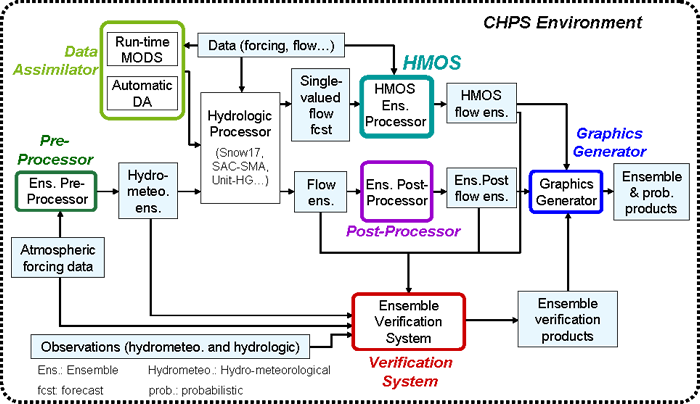|
Main Link Categories: Home | HSMB | HL | OHD | NWS |
NOAA / NWS Hydrologic Ensemble Forecasting[Last updated: October 25, 2016] |
|
System Overview – XEFS and HEFS XEFS Components (Prototypes)
Data Assimilator Ensemble Post-processor (EnsPost) Hydrologic Model Output Statistics (HMOS) Ensemble Verification System (EVS) Graphics Generator (GraphGen) [Video Training, NOAA login (email minus @noaa.gov) required]  (GraphGen has been updated from V1.1.1 to V1.2 on April 14, 2011. EVS has been updated from V5.5 to V5.6 on August 1, 2016) (GraphGen has been updated from V1.1.1 to V1.2 on April 14, 2011. EVS has been updated from V5.5 to V5.6 on August 1, 2016)System Overview - XEFS and HEFSProviding uncertainty – quantified flood forecasts and water management products is one of the most pressing needs of operational hydrologic forecasting. To address this need, the NWS Office of Hydrologic Development (OHD) is developing the EXperimental Ensemble Forecast Service (XEFS), an integrated short- to long-range hydrologic ensemble prediction system for testing and use at NWS River Forecast Centers (RFCs). The XEFS includes the following prototype capabilities (see diagram below): the Ensemble Pre-processor, the Ensemble Post-processor, the Hydrologic Model Output Statistic (HMOS), the Ensemble Data Assimilator, the Ensemble Verification System (EVS), and the Graphics Generator. The XEFS prototype components are developed within the NOAA’s Community Hydrologic Prediction System (CHPS). The EVS can also be run outside the CHPS environment as a stand-alone application. After rigorous evaluation, OHD software engineers will transform the XEFS prototype components into the operational Hydrologic Ensemble Forecast Service (HEFS). 
XEFS Components (Prototypes)The EPP is designed to generate short- to long-term ensemble forecasts of precipitation and temperature for operational models to produce streamflow ensembles. EPP consists of a precipitation component and a temperature one. Each component consists of a parameter estimation program and an ensemble generation program. The current version of the EPP, EPP3 can be executed within the CHPS environment through an EPP3 model adapter. The Data Assimilator is designed to generate optimal initial states for operational hydrologic models to produce improved ensemble snowmelt and flow forecasts. It uses either deterministic or ensemble data assimilation algorithms to account for uncertainty in hydrologic models (e.g., model structure,parameters, and states) and observational data (e.g., model forcing and output). The assimilator will be incorporated into the open source data assimilation software (OpenDA, http://www.openda.org/joomla/index.php) to be used within the CHPS environment. Ensemble Post-processor (EnsPost) The EnsPost is designed to post-process the streamflow ensembles statistically to bias-correct in the mean and spread sense. This process accounts for biases and errors in operational models and their calibration. EnsPost consists of a calibration process and real-time operation process. EnsPost can be executed in the CHPS environment through an EnsPost model adapter. Hydrologic Model Output Statistics (HMOS) The HMOS is designed to directly model the total uncertainty associated with the operationally-produced single-valued streamflow forecast, and generate ensemble streamflow forecasts for any lead-time based on conditional simulation. It consists of calibration process, ensemble process, and hindcast process. HMOS can be executed within the CHPS environment via a HMOS model adapter. Ensemble Verification System (EVS) The EVS is designed for verifying ensemble forecasts of hydrologic and hydrometeorological variables, such as temperature, precipitation, streamflow and stage, issued at discrete locations (points or areas) for any lead time. A verification study with the EVS may be implemented through a Graphical User Interface or through a command prompt with an XML project file. The EVS will run as a standalone application on any operating system and within the CHPS environment, via a CHPS-EVS model adapter. Graphics Generator (GraphGen) [Video Training, NOAA login (email minus @noaa.gov) required] The Graphics Generator is designed to construct graphical and tabular products based on time series derived from other components of XEFS and CHPS. It consists of a graphical user interface that is seamlessly integrated within the CHPS interface, as well as a model adapter that allows for products to be generated within CHPS workflows. |